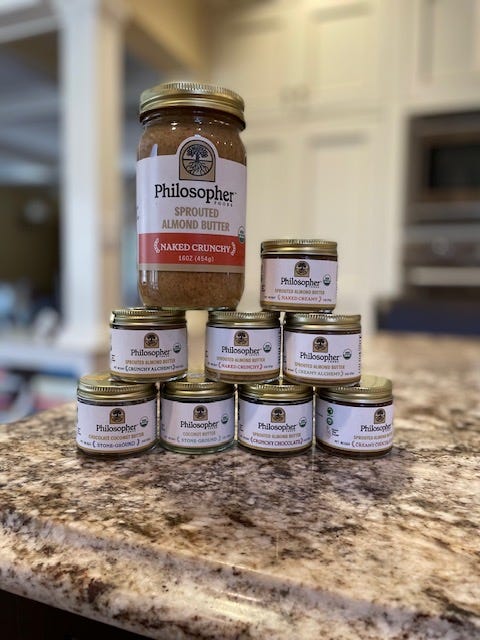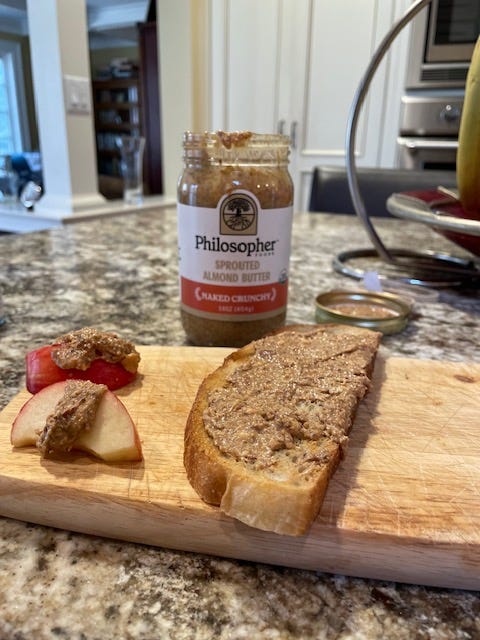Converting CA Almonds to Regenerative Agriculture / Hot Startup Alert: Philosopher Foods
The Almond Edition (48th) of the Negative Foods Newsletter
[I’m researching (a) chocolate with regenerative agricultural supply chains; and (b) recent developments in carbon labels and certifications. Please send your ideas!]
I love categories with substantial carbon emissions improvements from mainstream practices to regenerative agricultural practices. Beef is the most obvious example, because industrial beef producers are society’s worst climate actors, while beef produced regeneratively can draw down carbon from the atmosphere.
There’s a similar opportunity with the California almond industry, with a substantial carbon emissions improvement when comparing (a) mainstream almond farming and (b) the fast growing niche of growing almonds with regenerative practices.
California almond production has grown explosively, but the second most valuable agricultural commodity in the state is now facing severe headwinds. On top of long-brewing challenges, such as climate change and drought, conventional almond farmers are now also facing materially lower prices as they suffer rising input costs. Selling into the commodity markets is putting many conventional almond growers underwater. The silver lining is that conventional almond growers now have a clear motivation to convert to regenerative practices in the search for higher prices.
When we convert the almond industry to regenerative practices, we can make a big change in the carbon footprint of almond consumption, as the science appears to be firm that almonds, like other nuts, can be produced carbon negatively. According to a 2015 article from the Yale School of the Environment:
In a multi-year lifecycle assessment analyzing energy use and greenhouse gas emissions associated with typical almond orchard production systems in California, a team of researchers found that 1 kilogram of almonds produces less than 1 kilogram of carbon emissions. By improving the use of orchard biomass, California’s almond production could eventually become carbon neutral or carbon negative, she said. “Almond orchards capture and store a significant amount of carbon both above and below the surface over their 25 year lifecycle,” said [Alissa Kendall, Associate Professor of Civil Engineering at the University of California, Davis]. “This carbon storage provides a climate benefit not considered in conventional carbon footprints.”
Conventionally produced almonds, according to Brad Keith of SLM Partners, are “nitrogen hungry”, which means they need a lot of fertilizer, and conventionally produced almonds rely on synthetic fertilizer that emits enormous quantities of carbon. Regenerative almond production, on the other hand, is based on practices that deliver nitrogen to the almond trees from healthy soils.
Many farmers are concerned that converting to regenerative practices could result in lower yields, even though Ecdysis Foundation's research did not find a significant difference between yields of conventional v. regenerative almond systems (and showed much higher profits for regenerative practices). But I would expect that we’re unlikely to see large numbers of farms convert unless they can be fairly certain their efforts will be rewarded with higher pricing.
To catalyze the regenerative conversion, therefore, we need strong and growing market opportunities to incentivize farms to take the leap. And for that, we need branded food companies to market almond products that consumers will demand for the climate, water and nutrition benefits.
I’m optimistic. Clif Bar, a big purchaser of almonds, has for years been funding research on regenerative organic almond production. General Mills’ Lara Bar is publicly making investments in regenerative almond sourcing. Matt Billings, an almond farmer, has brought to market Ayo, an almond yogurt made with regeneratively grown almonds.
And I’m inspired by this week’s hot startup, Philosopher Foods. I recently spoke with Tim Richards, Philosopher’s founder and CEO (thank you for the introduction Anthony!). Tim and I both majored in philosophy in college. Tim has been grinding it out for nearly 10 years, and he’s gaining traction and recognition. Philosopher was recently named a finalist in the Expo West “Best New Regenerative Organic Certified Product” NEXTY Awards. I’ve been enjoying Tim’s delicious almond butter for the past week.
Philosopher is explicitly creating a market opportunity to incentivize almond producers to convert to regenerative practices, and I’m hopeful other CPG businesses will follow suit. As Tim says, “We're excited to announce that we're the first and only nut butter company to…use Regenerative Organic Certified ingredients.”
The flywheel appears to be gaining momentum. Brian Wahlbrink, the Chairman of the Almond Board of California, is a central California almond grower who has been converting some of his acres to regenerative practices, and has been sharing his learnings with the rest of the industry. Burroughs Family Farms is a long-time regenerative farm producing almonds regeneratively. In February, the Ecdysis Foundation sponsored a “Regenerative Almond Field Day” at the Burroughs Family Orchards, where 400 people experienced a regenerative orchard and learned how it functions.
It is surely early days for this movement, but I plan to do everything I can to support Philosopher Foods and other branded food companies creating market incentives to motivate more almond farms to convert to regenerative practices. Clif Bars will be my fuel on this weekend’s alpine touring adventures in the Gallatin National Forest with my awesome son Charley!
For Your Consideration:
7 Key Take-aways for Regenerative Food Systems from Expo West
How Does Carbon Credit Revenue Impact Ranchers?
Philosopher Foods: Taking on Degenerative Agriculture One Nut Butter at a Time
Can Small Seaweed Farms Help Kelp Scale Up?
Shell, Merck back regenerative agtech Vence for carbon & traceability capabilities
Grassroots regenerative agriculture provides hope and practical solutions
Agroforestry Funding For The Hudson Valley Region
Organic vs. Carbon Farming: What’s the Difference and Why Does it Matter?
Making Food Production More Sustainable—What Does It Mean?
AB InBev's EverGrain brings used beer ingredient to snacks and plant-based milks
The views in this newsletter belong solely to Paul Lightfoot (and not to BrightFarms or other organizations). This newsletter accepts no advertising. Learn more about this newsletter at https://paullightfoot.substack.com/about.






that's Ruthann not James Grossman
Paul, I am a big almond consumer..al. butter, al. flour, nuts etc. My big concern are the bees in crisis here in CA. without the bees there will be no pollination. We need more gardens that are bee friendly. Any thoughts on this?